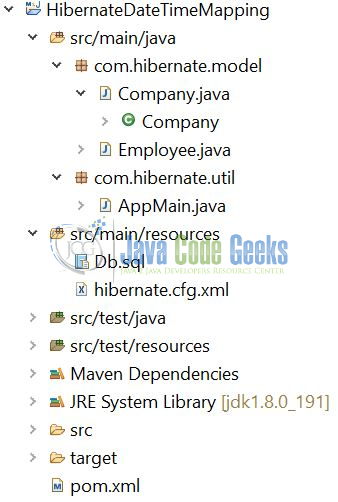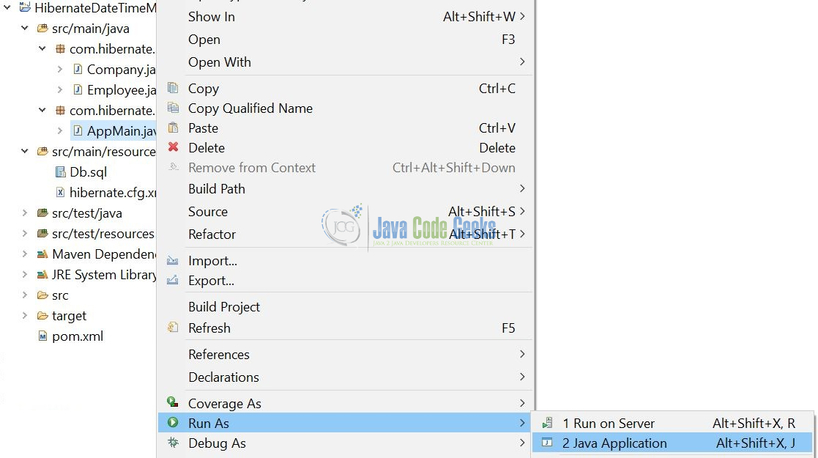Hibernate Manual and Always flush modes Example
In hibernate; flushing strategy is a process that controls how many times hibernate hits the database when it comes to writing operations. In this tutorial, we will explore the Always and Manual flushing strategies of the Hibernate framework.
1. Introduction
- Object-Relational Mapping or ORM is the programming technique to map application domain model objects to the relational database tables
- Hibernate is a Java-based ORM tool that provides the framework for mapping application domain objects to the relational database tables and vice versa. It provides the reference implementation of Java Persistence API that makes it a great choice as an ORM tool with benefits of loose coupling
- A Framework that an option to map plain old Java objects to the traditional database tables with the use of JPA annotations as well as
XMLbased configuration
1.1 Hibernate Annotations
- Hibernate annotations are the newest way to define mappings without the use of a
XMLfile - Developers use annotations to provide metadata configuration along with the Java code. Thus, making the code easy to understand
- XML provides the ability to change the configuration without building the project. Thus, annotations are less powerful than the
XMLconfiguration and should only be used for table and column mappings - Annotations are preconfigured with sensible default values, which reduce the amount of coding required. For e.g., Class name defaults to Table name and Field names default to Column names
1.2 Flushing strategy in Hibernate
The org.hibernate.FlushMode class represents the flushing strategy. It is a process to synchronize the database state with the session object by detecting the state changes and executing the SQL statements. The flushing behavior is customizable and hibernate supports four types of FlushMode i.e.
| Flushing Modes | Implementation |
|---|---|
| AUTO | The Session is sometimes flushed before query execution |
| COMMIT | The Session is only flushed prior to a transaction commit |
| ALWAYS | The Session is always flushed before query execution |
| MANUAL | The Session can only be manually flushed |
1.3 Download and Install Hibernate
You can read this tutorial in order to download and install Hibernate in the Eclipse IDE.
1.4 Download and Install MySQL
You can watch this video in order to download and install the MySQL database on your Windows operating system.
Now, open up the Eclipse IDE and let us see how to implement this tutorial in the hibernate framework!
2. Hibernate Manual and Always flush modes Example
Here is a systematic guide for implementing this tutorial in the hibernate framework.
2.1 Tools Used
We are using Eclipse Kepler SR2, JDK 8, MySQL database and Maven. Having said that, we have tested the code against JDK 1.7 and it works well.
2.2 Project Structure
Firstly, let us review the final project structure, in case you are confused about where you should create the corresponding files or folder later!

2.3 Project Creation
This section will demonstrate how to create a Java-based Maven project with Eclipse. In Eclipse IDE, go to File -> New -> Maven Project.

In the New Maven Project window, it will ask you to select the project location. By default, ‘Use default workspace location’ will be selected. Select the ‘Create a simple project (skip archetype selection)’ checkbox and just click on the next button to proceed.
It will ask you to ‘Enter the group and the artifact id for the project’. We will input the details as shown in the below image. The version number will be by default: 0.0.1-SNAPSHOT.
Click on Finish and the creation of a maven project is completed. If you observe, it has downloaded the maven dependencies and a pom.xml file will be created. It will have the following code:
pom.xml
<project xmlns="http://maven.apache.org/POM/4.0.0" xmlns:xsi="http://www.w3.org/2001/XMLSchema-instance" xsi:schemaLocation="http://maven.apache.org/POM/4.0.0 http://maven.apache.org/xsd/maven-4.0.0.xsd"> <modelVersion>4.0.0</modelVersion> <groupId>com.hibernate</groupId> <artifactId>HibernateAlwaysAndManualFlushMode</artifactId> <version>0.0.1-SNAPSHOT</version> <name>Hibernate Flush Mode Example</name> <packaging>jar</packaging> </project>
We can start adding the dependencies that developers want like Hibernate, MySQL etc. Let us start building the application!
3. Application Building
Below are the steps involved in developing this application.
3.1 Database and Table Creation
The following script creates a database called flushdb with a table: employee. Open MySQL terminal and execute the script.
CREATE DATABASE IF NOT EXISTS flushdb; USE flushdb; CREATE TABLE employee ( id INT(50) NOT NULL AUTO_INCREMENT, name VARCHAR(200) DEFAULT NULL, designation VARCHAR(200) DEFAULT NULL, department VARCHAR(200) DEFAULT NULL, PRIMARY KEY (id) );
If everything goes well, the table will be created.

3.2 Maven Dependencies
Here, we specify the dependencies for the Hibernate framework and the MySQL connector. Maven will automatically resolve the rest dependencies such as Hibernate Core, MySQL etc. The updated file will have the following code:
pom.xml
<project
xmlns="http://maven.apache.org/POM/4.0.0"
xmlns:xsi="http://www.w3.org/2001/XMLSchema-instance"
xsi:schemaLocation="http://maven.apache.org/POM/4.0.0 http://maven.apache.org/xsd/maven-4.0.0.xsd">
<modelVersion>4.0.0</modelVersion>
<groupId>com.hibernate</groupId>
<artifactId>HibernateAlwaysAndManualFlushMode</artifactId>
<version>0.0.1-SNAPSHOT</version>
<name>Hibernate Flush Mode Example</name>
<packaging>jar</packaging>
<dependencies>
<!-- https://mvnrepository.com/artifact/org.hibernate/hibernate-core -->
<dependency>
<groupId>org.hibernate</groupId>
<artifactId>hibernate-core</artifactId>
<version>5.3.7.Final</version>
</dependency>
<!-- https://mvnrepository.com/artifact/mysql/mysql-connector-java -->
<dependency>
<groupId>mysql</groupId>
<artifactId>mysql-connector-java</artifactId>
<version>8.0.13</version>
</dependency>
</dependencies>
<build>
<finalName>${project.artifactId}</finalName>
</build>
</project>
3.3 Java Class Creation
Let us write the Java classes involved in this application.
3.3.1 Implementation of Model Class
Add the following code to the model definition to map the attributes with the column names.
Employee.java
package com.hibernate.model;
import javax.persistence.Entity;
import javax.persistence.GeneratedValue;
import javax.persistence.GenerationType;
import javax.persistence.Id;
import javax.persistence.Table;
@Entity
@Table(name= "employee")
public class Employee {
@Id
@GeneratedValue(strategy= GenerationType.TABLE)
private int id;
private String name;
private String designation;
private String department;
public int getId() {
return id;
}
public void setId(int id) {
this.id = id;
}
public String getName() {
return name;
}
public void setName(String name) {
this.name = name;
}
public String getDesignation() {
return designation;
}
public void setDesignation(String designation) {
this.designation = designation;
}
public String getDepartment() {
return department;
}
public void setDepartment(String department) {
this.department = department;
}
}
3.3.2 Implementation of Utility Class
Add the following code to the implementation class for testing the flushing strategy in the Hibernate framework.
AppMain.java
package com.hibernate.util;
import java.math.BigInteger;
import org.hibernate.FlushMode;
import org.hibernate.Session;
import org.hibernate.cfg.Configuration;
import com.hibernate.model.Employee;
public class AppMain {
@SuppressWarnings("deprecation")
public static void main(String[] args) {
// Creating the config instance & passing the hibernate config file.
Configuration config = new Configuration();
config.configure("hibernate.cfg.xml");
// Hibernate session object to start the db transaction.
Session s = config.buildSessionFactory().openSession();
// Setting the flush mode.
s.setFlushMode(FlushMode.ALWAYS);
// s.setFlushMode(FlushMode.MANUAL);
// Creating the employee object.
Employee emp = new Employee();
emp.setName("Robin Clarke");
emp.setDesignation("Sr. Manager");
emp.setDepartment("Human Resources");
// Saving the data in the database.
s.getTransaction().begin();
s.save(emp);
// If developers are using the 'FlushMode.MANUAL', we'll have to explicitly use the 'flush()' method for committing the data
// to the database. If not, the data will be unflushed, and the output of Line 44 will be zero.
// s.flush();
// Fetching the data from the database.
BigInteger count = (BigInteger) s.createNativeQuery("select count(*) from Employee").getSingleResult();
System.out.println("Total records are= " + count);
s.getTransaction().commit();
// Closing the session object.
s.close();
}
}
3.4. Hibernate Configuration File
In the configuration file, we will include the database and the mapping class details.
hibernate.cfg.xml
<?xml version="1.0" encoding="UTF-8"?> <!DOCTYPE hibernate-configuration PUBLIC "-//Hibernate/Hibernate Configuration DTD 3.0//EN" "http://www.hibernate.org/dtd/hibernate-configuration-3.0.dtd"> <hibernate-configuration> <session-factory> <!-- Database connection settings --> <property name="hibernate.connection.driver_class">com.mysql.cj.jdbc.Driver</property> <property name="hibernate.connection.url">jdbc:mysql://localhost:3306/flushdb</property> <property name="hibernate.connection.username">root</property> <property name="hibernate.connection.password" /> <!-- Sql dialect --> <property name="hibernate.dialect">org.hibernate.dialect.MySQL5Dialect</property> <!-- Printing the sql queries to the console --> <property name="show_sql">true</property> <!-- Mapping to the create schema DDL --> <property name="hbm2ddl.auto">create</property> <!-- Model class --> <mapping class="com.hibernate.model.Employee" /> </session-factory> </hibernate-configuration>
Important points:
- Here, we instructed Hibernate to connect to a MySQL database named
flushdband the mapping class to be loaded - We have also instructed the Hibernate framework to use
MySQL5Dialecti.e. Hibernate will optimize the generated SQL statements for MySQL - This configuration will be used to create a hibernate
SessionFactoryobject show_sqltag will instruct the hibernate framework to log all the SQL statements on the console
4. Run the Application
To run the Hibernate application, Right-click on the AppMain class -> Run As -> Java Application. Developers can debug the example and see what happens after every step!
5. Project Demo
The code shows the following logs as the output of this tutorial.
// Logs for 'FlushMode.ALWAYS'. Hibernate: select tbl.next_val from hibernate_sequences tbl where tbl.sequence_name=? for update Hibernate: update hibernate_sequences set next_val=? where next_val=? and sequence_name=? Hibernate: insert into employee (department, designation, name, id) values (?, ?, ?, ?) Hibernate: select count(*) from Employee Total records are= 1 // Logs for 'FlushMode.MANUAL'. Hibernate: select tbl.next_val from hibernate_sequences tbl where tbl.sequence_name=? for update Hibernate: update hibernate_sequences set next_val=? where next_val=? and sequence_name=? Hibernate: select count(*) from Employee Total records are= 0
That is all for this tutorial and I hope the article served you whatever you were looking for. Happy Learning and do not forget to share!
6. Conclusion
This post defines the implementation of the flushing strategy in the Hibernate framework and helps developers understand the basic configuration required to achieve this. Developers can download the sample application as an Eclipse project in the Downloads section.
7. Download the Eclipse Project
This was an example of Always and Manual flushing strategies in the Hibernate framework for beginners.
You can download the full source code of this example here: HibernateAlwaysAndManualFlushMode







